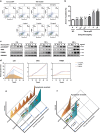p53 dynamics orchestrates with binding affinity to target genes for cell fate decision
- PMID: 29048401
- PMCID: PMC5682658
- DOI: 10.1038/cddis.2017.492
p53 dynamics orchestrates with binding affinity to target genes for cell fate decision
Abstract
Emerging evidence support that temporal dynamics is pivotal for signaling molecules in orchestrating smart responses to diverse stimuli. p53 is such a signaling molecule that employs temporal dynamics for the selective activation of downstream target genes and ultimately for cell fate decision. Yet how this fine-tuned p53 machinery is quantitatively decoded remains largely unclear. Here we report a quantitative mechanism defining how p53 dynamics orchestrates with binding affinity to target genes for cell fate decision. Treating cells with a genotoxic drug doxorubicin at various doses and durations, we found that a mild and prolonged challenge triggered sequential p53 pulses and ultimately resulted in a terminal pulse enacting apoptosis in a comparable rate with that induced by an acute and high-dose treatment. To transactivate proapoptotic genes and thereafter executing apoptosis, p53 must exceed a certain threshold and accumulate for sufficient time at levels above it. Effective cumulative levels above the threshold, defined as E∫p53, but not the total accumulation levels of p53, precisely discriminate survival and apoptotic cells. p53 accumulation below this threshold, even with prolonging time to reach a total level comparable to that from the accumulation over the threshold, could not transactivate proapoptotic genes to which the binding affinity of p53 is lower than that of proarrest genes, and this property is independent of dynamic features. Our findings indicate that the dynamic feature per se does not directly control cell fate, but rather it orchestrates with the binding affinity to target genes to confer an appropriate time window for cell fate choice. Our study provides a quantitative mechanism unifying p53 dynamics and binding affinity to target genes, providing novel insights to understand how p53 can respond quantitatively to chemotherapeutic drugs, and guiding the design of metronomic regimens for chemotherapeutic drugs.
Conflict of interest statement
The authors declare no conflict of interest.
Figures





Similar articles
-
Mathematical model identifies effective P53 accumulation with target gene binding affinity in DNA damage response for cell fate decision.Cell Cycle. 2018;17(24):2716-2730. doi: 10.1080/15384101.2018.1553342. Epub 2018 Dec 10. Cell Cycle. 2018. PMID: 30488759 Free PMC article.
-
A threshold mechanism mediates p53 cell fate decision between growth arrest and apoptosis.Cell Death Differ. 2013 Apr;20(4):576-88. doi: 10.1038/cdd.2012.155. Epub 2013 Jan 11. Cell Death Differ. 2013. PMID: 23306555 Free PMC article.
-
Phosphorylated Hsp27 activates ATM-dependent p53 signaling and mediates the resistance of MCF-7 cells to doxorubicin-induced apoptosis.Cell Signal. 2013 May;25(5):1176-85. doi: 10.1016/j.cellsig.2013.01.017. Epub 2013 Jan 26. Cell Signal. 2013. PMID: 23357534
-
The cell death machinery governed by the p53 tumor suppressor in response to DNA damage.Cancer Sci. 2010 Apr;101(4):831-5. doi: 10.1111/j.1349-7006.2010.01488.x. Epub 2010 Feb 3. Cancer Sci. 2010. PMID: 20132225 Free PMC article. Review.
-
Decision making by p53: life, death and cancer.Cell Death Differ. 2003 Apr;10(4):431-42. doi: 10.1038/sj.cdd.4401183. Cell Death Differ. 2003. PMID: 12719720 Review.
Cited by
-
TOPAS-Tissue: A Framework for the Simulation of the Biological Response to Ionizing Radiation at the Multi-Cellular Level.Int J Mol Sci. 2024 Sep 19;25(18):10061. doi: 10.3390/ijms251810061. Int J Mol Sci. 2024. PMID: 39337547 Free PMC article.
-
Recombinant Human Adenovirus-p53 Therapy for the Treatment of Oral Leukoplakia and Oral Squamous Cell Carcinoma: A Systematic Review.Medicina (Kaunas). 2021 May 1;57(5):438. doi: 10.3390/medicina57050438. Medicina (Kaunas). 2021. PMID: 34062896 Free PMC article.
-
Chromosome Instability in Fanconi Anemia: From Breaks to Phenotypic Consequences.Genes (Basel). 2020 Dec 21;11(12):1528. doi: 10.3390/genes11121528. Genes (Basel). 2020. PMID: 33371494 Free PMC article. Review.
-
Pulsed stimuli enable p53 phase resetting to synchronize single cells and modulate cell fate.Mol Syst Biol. 2025 Apr;21(4):390-412. doi: 10.1038/s44320-025-00091-8. Epub 2025 Mar 3. Mol Syst Biol. 2025. PMID: 40033003 Free PMC article.
-
Modulation of signaling cross-talk between pJNK and pAKT generates optimal apoptotic response.PLoS Comput Biol. 2022 Oct 14;18(10):e1010626. doi: 10.1371/journal.pcbi.1010626. eCollection 2022 Oct. PLoS Comput Biol. 2022. PMID: 36240239 Free PMC article.
References
Publication types
MeSH terms
Substances
LinkOut - more resources
Full Text Sources
Other Literature Sources
Research Materials
Miscellaneous

